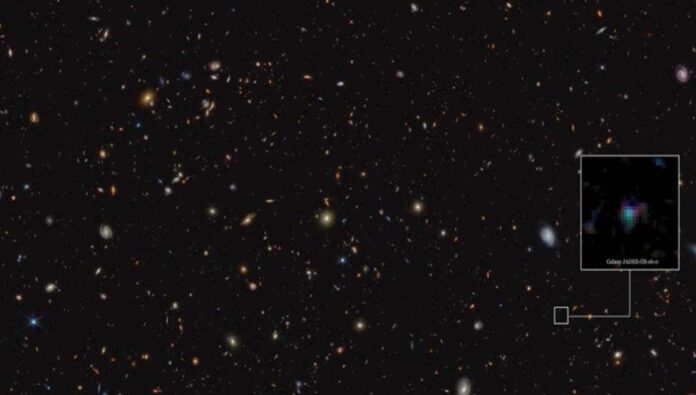For the first time, the James Webb Space Telescope has observed the chemical signature of carbon-rich dust grains in the early universe.
Similar observational signatures have been observed in the much more recent universe, and have been attributed to complex, carbon-based molecules known as polycyclic aromatic hydrocarbons (PAHs). It is not thought likely, however, that PAHs would have developed within the first billion years of cosmic time.
The international team, including researchers from the University of Cambridge, say that Webb may have observed a different species of carbon-based molecule: possibly minuscule graphite- or diamond-like grains produced by the earliest stars or supernovas. Their results, which suggest that infant galaxies in the early universe developed much faster than anticipated, are reported in the journal Nature.
The seemingly empty spaces in our universe are in reality often not empty at all, but are filled by clouds of gas and cosmic dust. This dust consists of grains of various sizes and compositions that are formed and ejected into space in a variety of ways, including by supernova events.
This material is crucial to the evolution of the universeevolution of the universe, as dust clouds ultimately form the birthplaces for new stars and planets. However, the dust absorbs stellar light at certain wavelengths, making some regions of space challenging to observe.
An upside is that certain molecules will consistently absorb or otherwise interact with specific wavelengths of light. This means that astronomers can get information about the cosmic dust’s composition by observing the wavelengths of light that it blocks.
The Cambridge-led team of astronomers used this technique, combined with Webb’s extraordinary sensitivity, to detect the presence of carbon-rich dust grains only a billion years after the birth of the universe.
“Carbon-rich dust grains can be particularly efficient at absorbing ultraviolet light with a wavelength around 217.5 nanometers, which for the first time we have directly observed in the spectra of very early galaxies,” said lead author Dr. Joris Witstok from Cambridge’s Kavli Institute for Cosmology.
This 217.5-nanometer feature has previously been observed in the much more recent and local universe, including within our own Milky Way galaxy, and has been attributed to two different types of carbon-based molecules: polycyclic aromatic hydrocarbons (PAHs) or nano-sized graphitic grains.
According to most models, it should take several hundreds of millions of years before PAHs form, so it would be surprising if the team had observed the chemical signature of molecules that shouldn’t have formed yet. However, according to the researchers, this result is the earliest and most distant direct signature for this carbon-rich dust grain.
The answer may lie in the details of what was observed. The feature observed by the team peaked at 226.3 nanometers, not the 217.5-nanometer wavelength associated with PAHs and tiny graphitic grains. A discrepancy of less than ten nanometers could be accounted for by measurement error. Equally, it could also indicate a difference in the composition of the early universe cosmic dust mixture that the team detected.
“This slight shift in wavelength of where the absorption is strongest suggests we may be seeing a different mix of grains, for example, graphite- or diamond-like grains,” said Witstok, who is also a Postdoctoral Research Associate at Sidney Sussex College. “This could also potentially be produced on short timescales by Wolf-Rayet stars or by material ejected from a supernova.”
Models have previously suggested that nano-diamonds could be formed in the material ejected from supernovasmaterial ejected from supernovas; and huge, hot Wolf-Rayet stars, which live fast and die young, would give enough time for generations of stars to have been born, lived, and died, to distribute carbon-rich grains into the surrounding cosmic dust in under a billion years.
However, it is still a challenge to fully explain these results with the existing understanding of the early formation of cosmic dust. These results will go on to inform the development of improved models and future observations.
With the advent of Webb, astronomers are now able to make detailed observations of the light from individual dwarf galaxies, seen in the first billion years of cosmic time. Webb finally permits the study of the origin of cosmic dust and its role in the crucial first stages of galaxy evolution.
“This discovery was made possible by the unparalleled sensitivity improvement in near-infrared spectroscopy provided by Webb, and specifically its Near-Infrared Spectrograph (NIRSpec),” said co-author Professor Roberto Maiolino, who is based in the Cavendish Laboratory and the Kavli Institute for Cosmology. “The increase in sensitivity provided by Webb is equivalent, in the visible, to instantaneously upgrading Galileo’s 37-millimeter telescope to the 8-meter Very Large Telescope, one of the most powerful modern optical telescopes.”
The team is planning further research into the data and this result. “We are planning to work with theorists who model dust production and growth in galaxies,” said co-author Irene Shivaei of the University of Arizona/Centro de Astrobiología (CAB). “This will shed light on the origin of dust and heavy elements in the early universe.”
These observations were made as part of the JWST Advanced Deep Extragalactic Survey, or JADES. This program has facilitated the discovery of hundreds of galaxies that existeddiscovery of hundreds of galaxies that existed when the universe was less than 600 million years old, including some of the farthest galaxies known to date.
“I’ve studied galaxies in the first billion years of cosmic time my entire career and never did we expect to find such a clear signature of cosmic dust in such distant galaxies,” said co-author Dr. Renske Smit from Liverpool John Moores University. “The ultradeep data from JWST is showing us that grains made up of diamond-like dust can form in the most primordial of systems. This is completely overthrowing models of dust formation and opening up a whole new way of studying the chemical enrichment of the very first galaxies.”
Reference:
Joris Witstok, Carbonaceous dust grains seen in the first billion years of cosmic time, Nature (2023). DOI: 10.1038/s41586-023-06413-w.
